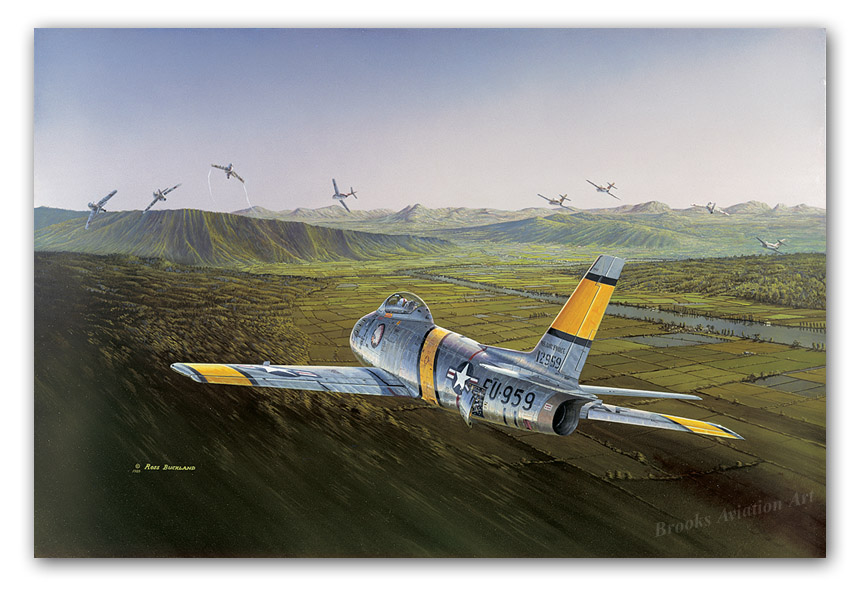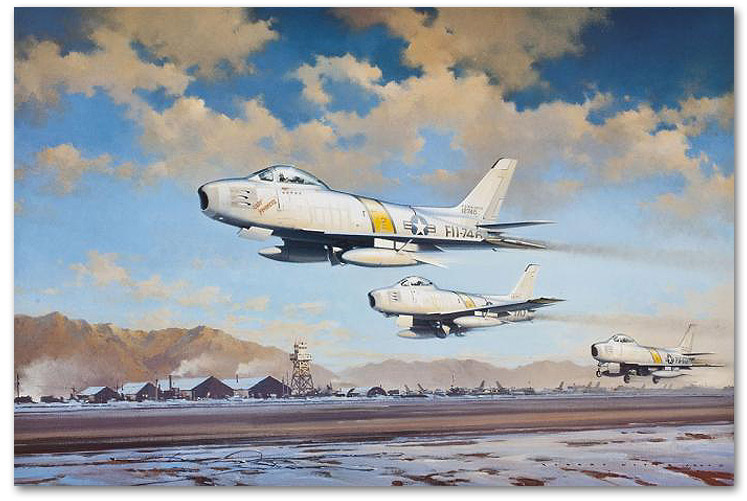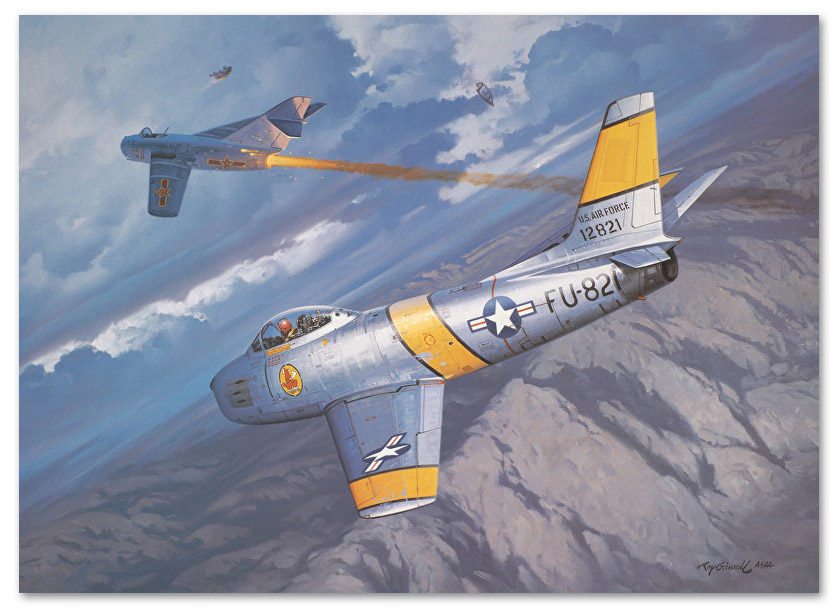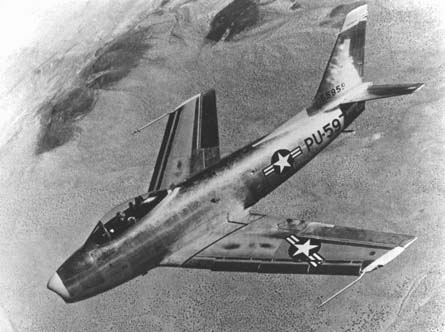Skip to comments.
The FReeper Foxhole Remembers Bud Farrell - 19th Bomb Group Korea (1952)- May 21st, 2003
http://home.att.net/~sallyann4/farrell1.html ^
| Bud Farrell
Posted on 05/21/2003 5:33:50 AM PDT by SAMWolf
|

Dear Lord,
There's a young man far from home,
called to serve his nation in time of war;
sent to defend our freedom
on some distant foreign shore.
We pray You keep him safe,
we pray You keep him strong,
we pray You send him safely home ...
for he's been away so long.
There's a young woman far from home,
serving her nation with pride.
Her step is strong, her step is sure,
there is courage in every stride.
We pray You keep her safe,
we pray You keep her strong,
we pray You send her safely home ...
for she's been away too long.
Bless those who await their safe return.
Bless those who mourn the lost.
Bless those who serve this country well,
no matter what the cost.
Author Unknown
.
FReepers from the The Foxhole
join in prayer for all those serving their country at this time.
.

................................................................................................................................. |
|
|
|
|
|
|
U.S. Military History, Current Events and Veterans Issues
 Where Duty, Honor and Country
Where Duty, Honor and Country
are acknowledged, affirmed and commemorated.
|

| Our Mission: The FReeper Foxhole is dedicated to Veterans of our Nation's military forces and to others who are affected in their relationships with Veterans.
Welcome to "Warrior Wednesday"
Where the Freeper Foxhole introduces a different veteran each Wednesday. The "ordinary" Soldier, Sailor, Airman or Marine who participated in the events in our Country's history. We hope to present events as seen through their eyes. To give you a glimpse into the life of those who sacrificed for all of us - Our Veterans.
To read previous Foxhole threads or
to add the Foxhole to your sidebar,
click on the books below.
|
|
|
|
|
|
Resource Links For Veterans 
Click on the pix
|
The B-29 in Mig Alley
After the disastrous B-29 vs. MiG-15 air battle of October 23, 1951, which later became known as Black Thursday, with the loss of several 307th B-29's to MiG-15's over Namsi, North Korea, the 3 B-29 Groups (the 19th Bomb Group, and 98th and 307th Bomb Wings) had to revert to night missions and rely on the cover and protection of darkness, with very few daylight raid exceptions for the balance of the war which ended on July 27, 1953. The MiG-15 had made the B-29 obsolete, and there was no immediate replacement aircraft yet available or appropriate for the type of missions required. B-29's had flown everything from frontline support, dropping on enemy troop concentrations, bombing of rail lines, road supply truck routes, bridges, refineries, factories and last, but NOT least, North Korean airfields.

Bud Farrell
The vulnerability of the B-29s, even under cover of darkness, was further proven on the night of June 10, 1952. Over the relatively innocuous railway bridge targets of Kwaksan, MiG-15's destroyed 3 and badly damaged several others of the 19th Bomb Group out of Kadena Air Force Base on Okinawa. All were caught in searchlights and then jumped by MiGS!
Our crew arrived in the 19 Bomb Group on June 21 1952 -- 10 days later
The apprehension from recent losses was very great and very unsettling to us "rookies". There was a great deal of gallows humor about "you won't need this or that very long". I, of course, was, and shall forever more be, commonly imposed on the new kids on the block! We had our turn six months later as we were getting ready to go home! But now it was " our turn in the barrel".
After several orientation flights and related sessions with the Group Flight Surgeons Office on how to give in-flight blood transfusions etc, with the blood plasma kits we carried aboard the aircraft, we were ready for our first combat mission as a full crew. One of the first and most shocking briefing instructions to the Gunners, (including the Bombardier/Nose Gunner) was that we were "absolutely NOT to fire unless we were clearly fired upon"!. This went against the grain of everything we had been trained to do - a year and a half of intense Gung Ho "slug -it -out" simulated attacks with gun camera passes by F-51 Mustangs and F-80 Shooting Star Jets over Colorado, Wyoming, Texas and Louisiana. What the hell is this.... " DON'T SHOOT-"

We were initiated on the night of July 3/4th. On our first mission, a MiG-15 appeared just off our left wing flying formation with us, very close in! The more senior gunner on the crew we were replacing, Brownie, said "Watch this", and he took an Aldis lamp ( similar to the current Q-Beam Sport Type plug- in Spot Light) which was used for visual checks in the darkness for wing and control surface damage, engine checks, etc., and he held it in front of his face and under his chin . like we did as kids playing "flashlight'. He clicked it on, damn near blinding us in the gunners' compartment, and was making faces and giving the MiG the FINGER!
"What the hell ......"
With that, the cockpit light of the MiG comes on. The MiG drops its landing gear to slow down, is flying superb formation with us at our left wing tip and now HE is giving US the finger! My heart is in my throat and these two are playing an early version of "road rage" I On the way back to Okinawa (about a 4 hour trip) I got a REAL briefing and the following was what was going on.
Earlier fighter aircraft, prop or jet propelled, had to fly what is called a "pursuit curve" - the manuever so frequently illustrated in pictures - of a pilot's two hands making a pass at each other, with one having to make constant adjustment to the movement and changes in direction of the other. This "leading", or pointing of the nose of the attacking aircraft then required some distance from the target in order to make the adjustments while spotting, sighting, and making a firing pass. If the guy in close attempted to point his nose at you, he was past you before he could even bring the fighter's gun platform to bear! Too CLOSE to the target and he was past the target before firing. Too FAR out in the dark and he had NO target, due to loss of visual sighting. There were then, in 1952, no air-to-air heat seeking or guided missiles, only ballistic missiles which went directly where they were pointed until they burned out and fell to the ground if missing the target - another aircraft.

Thus if the target, a bomber, had a fighter find it in the darkness by chance, following a slightly visible exhaust stack torch, spotted in a bright moonlight, or whatever, the fighter could stay with the bomber, fly close in and attempt to draw fire as another Bogey sat off a little ways getting vectored in with altitude, airspeed, heading, from the "Decoy". He could then make a pass - a pursuit curve -firing at the flashes from the multiple 50's of the bombers turrets, as the decoy dropped or dashed away to safety. No fire, no flashes. No damage, no losses!
The value of a B-29, and its 11 or 12 man crew, was far greater than the possible reward of a single MiG-15 with a relatively inexperienced North Korean or Chinese Pilot. In 1952 some Russian, Czech, and Polish Pilots were flying MiG's in combat over the Yalu. Nicknamed the "HONCHOS", they were experienced World War II pilots polishing new jet skills and tactics, as were many of our fighter pilots, including many WW II Reservists recalled to active duty for Korea!
Tracking of bombers by fighters following up on vapor trails in cold weather, and in the brightness of moonlight, was another matter; and climatic conditions were well considered in the timing and altitude of bomb runs in order to preclude the creation of vapor trails whenever possible. But many aircraft were still lost or damaged under such unanticipated and changing conditions from briefing time to time over target, 4 or 5 hours later! We experienced many similar incidents of non-firing passes in the darkness on our next 24 missions, and of course we had some of our other 'friendlies" up there too - B-29's and fighters, another good reason for strict fire control.

But the air battles included a great deal more. With Radar Directed AAA (anti Aircraft Artillery) fire of 88s, 90s, 105s, and supposedly up to 120 MM heavy guns putting up a box barrage in front of and at the altitude known for the bomber stream (through recon aircraft, radar etc.), flying in single trail, a SHORAN RADAR ( Short Range Radar Navigation) Arc, each plane flying the same arc, 30 to 60 seconds horizontal and 500 foot vertical separation, of up to as many as 66 B-29s on a max effort target up along the Yalu River. If flak, searchlights, enemy aircraft dropping illuminating parachute flares above us, and MiGS, aren't a part of an air battle, then we weren't in many!
|
TOPICS: VetsCoR
KEYWORDS: 19thbombgroup; b29; budfarrell; freeperfoxhole; koreanwar; michaeldobbs; migalley; veterans; warriorwednesday
Navigation: use the links below to view more comments.
first 1-20, 21-40, 41-60, 61-80 ... 121-134 next last
In WW II, great formations of hundreds of aircraft were fired at by hundreds of heavy guns. The B-29 crews, for at least a few minutes on some targets, had EVERY gun concentrating on ONE aircraft -- "yours"! The searchlights from the I.P. (Initial Point) to the target were essentially to illuminate the B-29's for orbiting MiG's, not particularly to light up B-29 targets for the ground gun crews since most AAA guns were radar controlled anyway. While radar controlled searchlights "locked on" B-29's, frequently "coning" one B-29 at the apex of the lights, MiG's would pounce on the B-29 like Yellow Jackets out of their disturbed nest. The Antung MiG Base just across the Yalu/Border and within visual sight of most major Yalu River targets was operating up to 300 MiG-15's that could not be taken out on their Chinese/Manchurian Base Refuge due to the political vagaries of the Korean War.

Bud Farrell
In some "air battles", such as over the Suiho Hydroelectric Power Plant and Dam (then the 4th largest Hydro Plant and Dam in the World) on September 12, 1952, the searchlights were lined up like a boulevard on both sides of the Yalu River, tracking each aircraft that could not effectively jam (deflect) them with ECM (Electronic Counter Measures). The MiG's, in their intense pursuit of "coned targets", flew into and through some of their own flak. In spite of what was reported in official records and U.S.A.F. Korean Air War histories as a 307th Group ship shot down by fighters, that aircraft and crew were lost to a direct flak hit and resultant explosion with a full bomb load with burning wreckage falling on the Manchurian side of the River.
That aircraft was directly in front of us and we reported at debriefing 5 hours later that there was "'little or no possibility of survivors" and we were WRONG! The Right Gunner, 1 out of the 12 crew members aboard, had survived, evaded capture for 12 days, was a P.O.W. for 12 months, was repatriated in August of 1953 and I talked to him at Thanksgiving, 1998. But that's another story, the most incredible that I could relate!
After Suiho, we started to get Marine Night Fighter cover by F3D Sky Knights a side by side tandem seat radar jet fighter from Marine Squadron VMF(N)-513. On major Yalu targets the F3D's flew at higher altitudes, orbiting between the I.P. and target, waiting for calls for assistance from the vulnerable B-29's flying their straight and level NO evasion bomb runs! The security of having this cover was a great morale boost and we frequently had them fly and play almost in our prop wash in the dark, knowing that we, by agreement, were the "gang that couldn't shoot !!!!!!!! It was great practice for their radar tracking skills but initially a little unnerving having an unidentified Bogey virtually on our tail!

On one mission our Radar Observer shouted on interphone, "2 bandits (MiG's) comin' in at 10 o'clock, my side!"
Heart in my throat, I reacted, "'High or low-"
" I can't tell you that, our radar only shows azimuth (horizontal plain), NOT vertical or altitude!"
Peeled eyeballs never saw either of them but our flight engineer looking out his escape hatch window saw 2 rocket tail flames pass just above us on their way to our 4 o'clock level. We NEVER fired!
That same night at debriefing, reports of action and log position reports proved that one B-29 crew had also impulsively fired at an unidentified aircraft - another B-29 in our group, with a .50 caliber round stopping in the seat and underlying flak jacket of our Group Executive Officer, Capt. Eugene Smith!

In this strange war, with stranger limitations - political AND practical - B29's dropped 167,000 tons of HE and Incendiary Bombs, more than the total dropped on Japan by B-29's in WW II, excluding the A-Bombs, of course. We lost 34 B-29's in combat, several others -perhaps even more- to operational accidents related to equipment failure, severe weather, etc. And we lost several B-29's in the night raids of late December, 1952 and through Spring of 1953, but the crews still saddled up knowing they couldn't shoot back unless clearly fired upon, letting the other guy throw the "first sucker punch. What a marvelous gutsy gang, that gang that couldn't shoot ........
1
posted on
05/21/2003 5:33:51 AM PDT
by
SAMWolf
To: AntiJen; snippy_about_it; Victoria Delsoul; SassyMom; bentfeather; MistyCA; GatorGirl; radu; ...
When North Korea invaded South Korea June 25, 1950, the U.S. Air Force (USAF) was less than three years old. Prior to September 1947, the USAF was the U.S. Army Air Forces. Thus the Korean War was its first conflict—a tough, grueling conflict—as an independent service.

Part of the occupation forces in Japan, the organization responsible for the aerial defense of that country was the Far East Air Forces (FEAF), commanded by Lt. Gen. George E. Stratemeyer. FEAF consisted of three air forces scattered across the western Pacific, the Fifth, Thirteenth, and Twentieth. It was Maj. Gen. Earle E. "Pat" Partridge's Fifth Air Force in Japan that would bear the brunt of the Korean fighting. Like the other services, FEAF suffered from severe post-World War II cutbacks in budget, equipment, and personnel. Nonetheless, FEAF was ready for action when the war erupted.
The first USAF plane destroyed in the war was a disabled C-54 transport caught by enemy fighters at Seoul's Kimpo Airfield. Some 1,465 additional USAF planes would be lost to various causes before the conflict ended. Only 10 percent of these losses would be in air-to-air combat. FEAF's initial actions of the war were defensive, primarily protecting transport aircraft and ships carrying civilians evacuating Korea. On June 27, while performing such cover missions, F-82 Twin Mustang all-weather interceptors shot down three YAK fighters attempting to interfere with the evacuations. A few hours later, four more enemy planes fell to F-80 jet fighters. These seven planes were the first of more than 975 enemy aircraft to be downed by FEAF planes in aerial combat.

By mid-July FEAF obtained not just air superiority but air supremacy wherein the opposing air force was incapable of effective interference. Such supremacy did not last, however. In November 1950, it appeared that the war might be over soon. Triumphant U.N. units had driven the retreating North Koreans before them and were now approaching the Yalu River and the Manchurian border. Suddenly, overwhelming numbers of Chinese Communist troops entered the battle and drove the U.N. forces back south of the 38th Parallel. Entering the fray at the same time was the MiG-15 jet fighter. With the appearance of this new and very dangerous adversary, the air war entered a new phase.
On November 8, 1950, 1st Lt. Russell Brown, flying an F-80, shot down a MiG-15 in the first all-jet dogfight in history. It was apparent, however, that the MiG-15 was superior to any aircraft then in FEAF's inventory. The MiG's pilots were also very good, being (for the most part) veteran Russian fliers. But FEAF soon had a counter to the MiG-15—the superb F-86A (and later, F-86E/F) Sabre. Many of the Sabre pilots were veterans of World War II and their expertise showed. Soon the Sabres and MiGs were mixing it up over northwest Korea, an area that became known as "MiG Alley." On December 17, 1950, Lt. Col. Bruce Hinton WAS THE FIRST Sabre pilot to score the first of an estimated 818 MiG-15 kills.

While the war turned into a stalemate on the ground, MiG Alley remained a hot spot throughout the war. For a time the B-29s continued bombing targets in northwest Korea by day, but when MiG-15s shot down five Superfortresses in a week in October 1951, the big bombers began attacking only at night. Day after day, though, the Sabres (joined by F-84 Thunderjets or F-80s) swept into MiG Alley to meet the MiG-15s rising from their fields in Manchuria. Although the U.S. government directed that these fields were "off limits" to the FEAF aircraft, some of these planes occasionally strayed across the border in "hot pursuit" of enemy aircraft.
For the last two years of the war ground fighting was occasionally heavy and bloody and ground was lost and regained by both sides. The front line (which eventually ran from just south of the 38th Parallel on the west coast, along a line northeast to above the Parallel on the east coast) remained relatively static. FEAF aircraft continued to bomb bridges, warehouses, railroads, and other targets in North Korea in an effort to end the stalemate. Three interdiction operations, two named STRANGLE and another called SATURATE, tried to paralyze the enemy's transportation system upon which he relied for supplies. Weather and an inability to execute sustained night attacks thwarted these efforts.
Much more successful was FEAF's campaign to employ air power to pressure the Chinese into accepting an Armistice satisfactory to the United States. This "air pressure" campaign was perhaps a key factor in finally ending the war. Attacks, in June 1952, on four hydroelectric generating complexes at Suiho, Chosin, Fusen, and Kyosen opened the campaign. These raids were spectacularly successful; North Korea experienced a nearly total loss of electric power for two weeks and never regained its former level of generating capacity before the end of the war. Manchuria, too, suffered the loss of a quarter of its supply of electricity.

These onslaughts, though very damaging and painful, still did not bring the Communists to the Armistice table, but even more harrowing onslaughts were forthcoming. These took the form of attacks on North Korea's irrigation dams, which in essence hit the enemy in the breadbasket. In May 1953, FEAF planes shattered three of North Korea's 20 irrigation dams. The resulting floods wiped out roads, railroad tracks, and thousands of acres of rice fields. Even though the enemy soon repaired the damage, they had to reduce the water levels in all the dams so as to prevent flooding in case of attack. These precautions, however, also reduced the water available to the remaining rice crops.
The war dragged on for two more months and then, on July 27, 1953, it was over as the Armistice was at last signed. For FEAF the war ended in a flurry of action. In these last months the MiGs appeared in greater numbers than ever. In one furious battle on June 30, 16 MiGs fell to Sabre guns — the most ever in a single air combat action involving the F-86 jet aircraft.
A statistical summary reveals the magnitude and ferocity of the Korean air war. FEAF grew from a force of 33,625 personnel in June 1950, to nearly 112,200 officers and airmen in July 1953. In the summer of 1950, FEAF controlled just 16 groups, 44 squadrons, and 657 aircraft. At its highest point, in the summer of 1952, FEAF controlled 20 groups, 70 squadrons, and 1,441 aircraft.

During the war, FEAF units flew 720,980 sorties and delivered 476,000 tons of ordnance. For these numbers FEAF estimated it had killed nearly 150,000 North Korean and Chinese troops and claimed the destruction of more than 975 aircraft, 800 bridges, 1,100 tanks, 800 locomotives, 9,000 railroad cars, 70,000 motor vehicles, and 80,000 buildings. This damage was inflicted at the cost of 1,841 men killed, wounded and missing, and 750 aircraft destroyed by the enemy. Four USAF fliers were posthumously awarded the Medal of Honor for their actions in the war. The furious air battles in the North Korean skies also resulted in 38 USAF pilots scoring five or more victories to become aces. Leading the way was Capt. Joseph C. McConnell Jr., with 16 MiGs to his credit.
No one service can claim to have single-handedly won the war. But each contributed immeasurably to the effort, and the Air Force was no exception. The brave men and women who served in the FEAF answered their country's call to defend freedom in a far away land. Many paid with their lives, and all who served deserve this nation's gratitude. The men and women of FEAF know first hand that Freedom is not Free.
Additional Sources: www.wpafb.af.mil
www.rt66.com
korea50.army.mil
www.brooksart.com
www.wpafb.af.mil
www.ngb.army.mil
2
posted on
05/21/2003 5:34:19 AM PDT
by
SAMWolf
((A)bort (R)etry (A)sk 12 Year Old?)
To: All
Sinuiju and Antung, located along the Yalu River in northeastern North Korea, were the main operating bases for Communist MiG-15 fighter units. While Sinuiju was located in North Korea, and therefore could be bombed, Antung was located just across the river in Manchuria and could not be attacked.

Large formations of MiGs would lie in wait on the Manchurian side of the border. When UN aircraft entered the airspace that became known as "MiG Alley," they would swoop down from high altitude to attack. If the MiGs ran into trouble, they would try to escape back to the safety of the border. Even with the advantage of a sanctuary across the Yalu, Communist pilots still could not compete against the better-trained Sabre pilots of the USAF.
The Sabre's combat record in Korea was, by any standards, impressive. Of the 900 aerial victories claimed by USAF pilots during the war, 792 were MiG-15s shot down by Sabres. The MiGs in their turn managed to knock down only 78 Sabres. American fighter pilots thus established a ten-to-one kill/loss ration in their favor.
Documented postwar research indicates there were actually only about 379 US victories.
Whatever the actual victories and losses this was quite an accomplishment, against the odds. |
3
posted on
05/21/2003 5:34:43 AM PDT
by
SAMWolf
((A)bort (R)etry (A)sk 12 Year Old?)
To: All
The State of the Union is Strong!
Support the Commander in Chief
Click Here to Send a Message to the opposition!
4
posted on
05/21/2003 5:35:09 AM PDT
by
SAMWolf
((A)bort (R)etry (A)sk 12 Year Old?)
To: All
5
posted on
05/21/2003 5:35:34 AM PDT
by
SAMWolf
((A)bort (R)etry (A)sk 12 Year Old?)
To: Reaganwuzthebest; weldgophardline; Mon; AZ Flyboy; feinswinesuksass; Michael121; cherry_bomb88; ...
FALL IN to the FReeper Foxhole!
To be removed from this list, please send me a blank private reply with "REMOVE" in the subject line! Thanks! Jen
6
posted on
05/21/2003 5:39:40 AM PDT
by
SAMWolf
((A)bort (R)etry (A)sk 12 Year Old?)
To: SAMWolf

JAVELIN — Marines of 2nd Battalion, 6th Marines, fire a Javelin anti-tank missile at Blair Air Field, Iraq. U.S. Marine Corps photo by Sgt. Mauricio Campino

AT THE READY — While moving through Al Hay, Iraq, Marine riflemen with 2nd Battalion, 6th Marines aim their M16 rifles and M249 squad-automatic weapons out of a seven-ton truck after shots are fired in the city. U.S. Marine Corps photo by Sgt. Mauricio Campino
7
posted on
05/21/2003 5:54:21 AM PDT
by
SAMWolf
(The good Lord didn't create anything without a purpose, but mosquitoes come close.)
To: SAMWolf

Wednesday's weird warship, the russian battleship "Twelve Apostles"
This ship was chosen as a weird warship based on its name, and on the strange translation of Russian to English found on the website Russian Battleships.
Technical characteristics
Displacement 8438 t.
It is long 104,2 m.
Width 18,3 m.
Sagging 8,8 m.
Power of the mechanisms 8758 hp.
Running speed 15,7 knots
Cruising range 1500 miles (by 10- main motion)
Armoring from 203 to 356 mm
the crew 599 people
Armament
305- mm 4
152- mm 4
63- mm 2
47- mm 12
37- mm 14
The torpedo tubes 6
It is laid in 1889 on by Nikolayevsk the admiralty, on 13 September, 1890, it is gone down to the water and in 1892 entered the system. Until 13 February, 1892, it counted by armored ship. During April 1907 it is brought out from the fighting strength of fleet, it is disarmed and in 1912 re-equipped into the " blockship?8 ". From the spring 1918 it was found on the storage in the Sevastopol military port, and in 1922 it was selected to the metal.
8
posted on
05/21/2003 6:04:12 AM PDT
by
aomagrat
(IYAOYAS)
To: SAMWolf
Salute to Bud Farrell. Good stuff as always this morning Sam.
To: SAMWolf
BTTT!!!!!!
10
posted on
05/21/2003 6:18:11 AM PDT
by
E.G.C.
To: SAMWolf
11
posted on
05/21/2003 6:18:30 AM PDT
by
GailA
(Millington Rally for America after action http://www.freerepublic.com/focus/f-news/872519/posts)
To: aomagrat
LOL I love the Russian translation.
I don't know if I should be worried because I understood it.
12
posted on
05/21/2003 6:34:58 AM PDT
by
SAMWolf
(The good Lord didn't create anything without a purpose, but mosquitoes come close.)
To: *all
|
Air Power
North American F-86 "Sabre"
 |
The F-86, the USAF's first swept-wing jet fighter, made its initial flight on October 1, 1947. The first production model flew on May 20, 1948, and on September 15, 1948, an F-86A set a new world speed record of 670.9 mph. Originally designed as a high-altitude day-fighter, it was subsequently redesigned into an all-weather interceptor (F-86D) and a fighter-bomber (F-86H).
As a day fighter, the airplane saw service in Korea in three successive series (F-86A, E, and F) where it engaged the Russian-built MiG-15. By the end of hostilities, it had shot down 792 MiGs at a loss of only 76 Sabres, a victory ratio of 10 to 1.
More than 5,500 Sabre day-fighters were built in the U.S. and Canada. The airplane was also used by the air forces of 20 other nations, including West Germany, Japan, Spain, Britain, and Australia.
Specifications:
Primary Function: Fighter
Contractor: North American
Crew: One
Unit Cost: $178,000
Powerplant: One General Electric J-47 turbojet of 5,200 lbs thrust
Dimensions:
Length: 37 ft. 6 in.
Wingspan: 37 ft. 1 in.
Height: 14 ft. 8 in.
Maximum Takeoff Weight: 13,791 lb. (loaded)
Performance:
Speed: 685 mph
Ceiling: 49,000 ft
Range: 1,200 miles
Armament: Six .50-cal. machine guns and eight 5 in. rockets or 2,000 lbs. of bombs





All photos Copyright the following websites:
Global Aircraft.Org
Wright Patterson Air Force Museum
Mig-Sabre Dogfight Group
13
posted on
05/21/2003 6:35:00 AM PDT
by
Johnny Gage
(The key to flying is to throw yourself to the ground.. AND MISS!)
To: ProudEagle
Thanks ProudEagle.
14
posted on
05/21/2003 6:35:31 AM PDT
by
SAMWolf
(The good Lord didn't create anything without a purpose, but mosquitoes come close.)
To: SAMWolf; snippy_about_it; *all
Good morning SAM, snippy, everyone.
To: GailA
Good Morning GailA. Beautiful graphic today.
16
posted on
05/21/2003 6:36:18 AM PDT
by
SAMWolf
(The good Lord didn't create anything without a purpose, but mosquitoes come close.)
To: Johnny Gage
Thanks Johnny.
The SaberJet was a sleek looking plane.
I remember having playsets with SaberJets as a kid.
17
posted on
05/21/2003 6:38:38 AM PDT
by
SAMWolf
(The good Lord didn't create anything without a purpose, but mosquitoes come close.)
To: SAMWolf; snippy_about_it; *all
To: bentfeather
Good Morning Feather
19
posted on
05/21/2003 6:39:23 AM PDT
by
SAMWolf
(The good Lord didn't create anything without a purpose, but mosquitoes come close.)
To: bentfeather
Nice graphic!
20
posted on
05/21/2003 6:40:05 AM PDT
by
SAMWolf
(The good Lord didn't create anything without a purpose, but mosquitoes come close.)
Navigation: use the links below to view more comments.
first 1-20, 21-40, 41-60, 61-80 ... 121-134 next last
Disclaimer:
Opinions posted on Free Republic are those of the individual
posters and do not necessarily represent the opinion of Free Republic or its
management. All materials posted herein are protected by copyright law and the
exemption for fair use of copyrighted works.
FreeRepublic.com is powered by software copyright 2000-2008 John Robinson

























